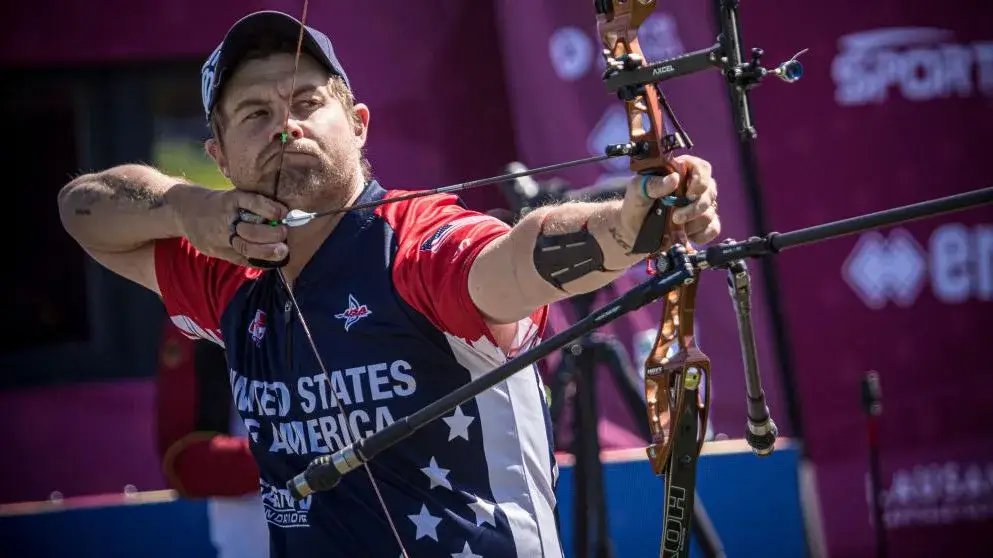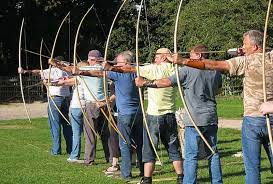For anyone tuning into the Olympics and seeing modern archery for the first time, their first reaction might be, ‘What the heck are they shooting with!? There are bits sticking out all over the place. Why don’t they just use longbows in the Olympics?
Traditional longbows are not used in the Olympics anymore because the sport of archery has evolved so much over the last few hundred years. Today’s modern archers taking part in competitions are in pursuit of pinpoint accuracy and precision over long distances. Something that traditional longbows are not capable of.
If you’re looking for a direct comparison between old and new, you could equate using a Longbow in the Olympics with attempting to use an old musket rifle for precision marksmanship.
In this article, we’ll look at exactly how competitive archery has evolved into the modern sport of precision that we see today. We’ll also look at where the Longbow fits in with today’s competition.

Why Don’t They Use Longbows In The Olympics?
When most people think of archery, they immediately conjure up an image of a medieval archer stalking a deer through a densely packed forest carrying a longbow.
They might have this romanticized image from having studied it in school, or seeing historical movies and playing video games. They see the traditional longbow as being the standard for archery.
What they don’t realize is that archery as a sport has evolved.
From the very first recorded archery competition held in Finsbury in 1583 to today’s modern Olympic competitions, the modern sport of archery has evolved into being a precision event, and not just a shooting event.
It requires precision equipment that enables participants to hit a competition target at 70m away, which is a very different prospect from hitting a backyard target at 7m.
Modern Olympic Recurve bows have been designed with pinpoint accuracy and modern point systems in mind. Something that the traditional Longbow is unable to deliver.
What Are The Differences Between a Longbow and a Modern Olympic Bow?
When compared side-by-side, the differences between a Longbow and an Olympic Recurve bow are immediately apparent.
The first thing that most people notice about the Recurve Bow is the shape of the limbs. They ‘Recurve’ back towards the archer. This shaping of the bow limbs allows for a more efficient energy transfer to the arrow than a straight-limbed bow.
The Longbow is basically a stripped-down stick of wood, typically Yew, that’s been crafted by hand into that familiar bow shape. It’s much taller than a Recurve bow at just over 6ft, with a heavier draw weight than a modern bow.
It was designed to be used as the first line of defence against an approaching enemy. It would be used to shower the opposition with a ‘rain of arrows’ from distances of over 200 yards.
A modern Recurve bow is composed of three parts. The upper and lower limbs, and the central hub, or riser. The riser is usually around 23 inches long and can be constructed of wood, carbon, or aluminium.
The riser is where the grip and the arrow rest are housed and where the limbs slot together.

If you’ve ever watched Olympic archery, you’ll notice that the bows have been fitted with all kinds of shooting aids. These are accessories that enable the archer to fine-tune their shot and create the most stable shooting platform possible.
Longbow archers mainly had to shoot instinctively, as the draw weights were too heavy to hold for a long enough period of time to aim successfully.
Are Longbows More Accurate Than Recurve Bows?
If you completely remove all human error from a shot, then nearly every bow would be accurate. You’ll find that all the bow does is fill in the gaps caused by human inconsistency.
Longbows have been recorded as shooting arrows at around 180 – 270 yards. Most scholars agree, however, it’s highly unlikely that accuracy would have extended beyond 75-80 yards in perfect weather conditions.

The original Longbows were strung with draw weights of up to 180lbs, so accuracy was not the bow’s main purpose. Modern Longbows are constructed with lower draw weights (around 70-90lbs), but it still takes a lot of skill and patience to shoot accurately with one.
Recurve Bows are more accurate overall than Longbows because they have been specifically designed for accuracy.
Longbow grips are straight, as opposed to the shaped grip of the recurve which makes it easier to be more consistent with your shot.
Most traditional bow hunters would probably be happy with tight groupings at 20yards, whereas Recurve archers would generally hit consistent groupings at
Do People Still Compete with Longbows?
Longbows still remain popular among traditional archers. You can still buy Longbows and there are plenty of places to shoot with them. You can also find plenty of competitions for Longbows. They just aren’t as high profile as the modern competition format.
You’ll find a lot of re-enactments of archery competitions from the middle-ages using Longbows, and traditional point scoring.
In the UK, Archery England oversees the only National Longbow Championships held in July at Sherwood Archers, Nottinghamshire.
For archers in the US, usarchery.org hold their traditional Longbow championships alongside their Recurve tournament. You can find out more about those right here.
Ask your local club for information as there is bound to be a Longbow league in your area.
Conclusion
Longbows are classic bows that are very much of their time, and therefore, when it comes to competitions, these more traditional bows need their own set of rules and guidelines.
Modern competitions use modern standards, modern bows, and modern point systems. This is why we don’t see Longbows in the Olympics today, and why see such a huge gap between what we perceive archery to be, or what we think it should be (the romanticized ideal) to what it actually is today.

0 Comments